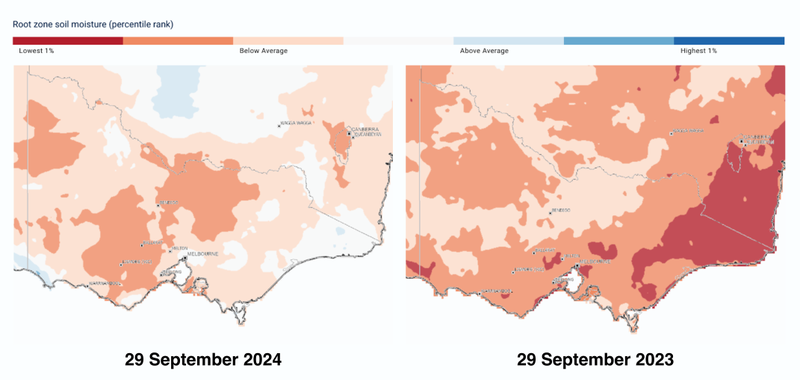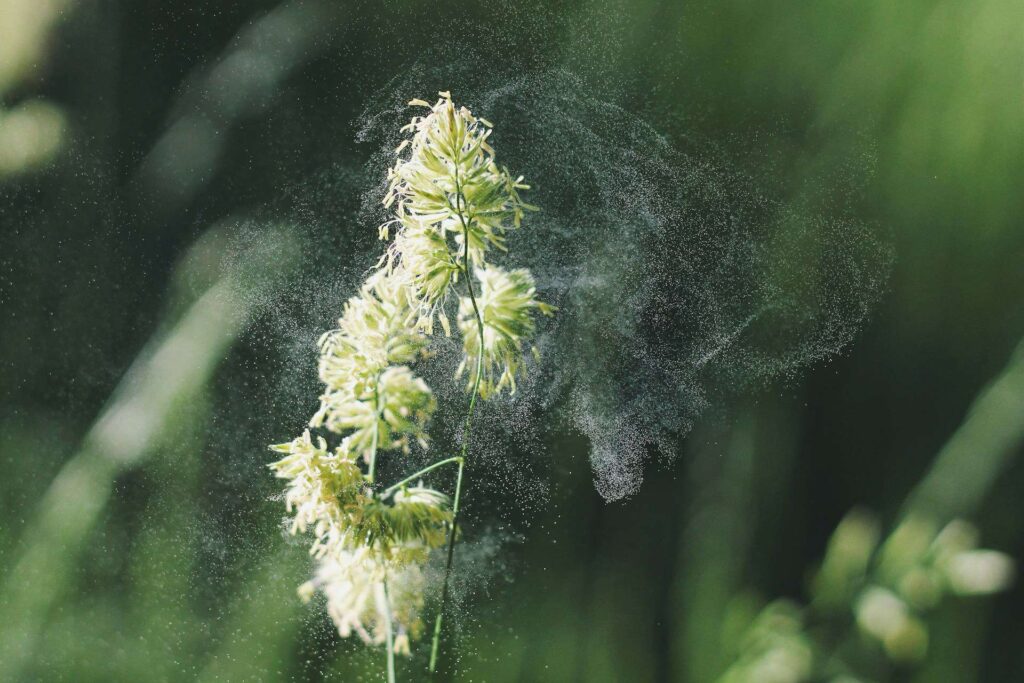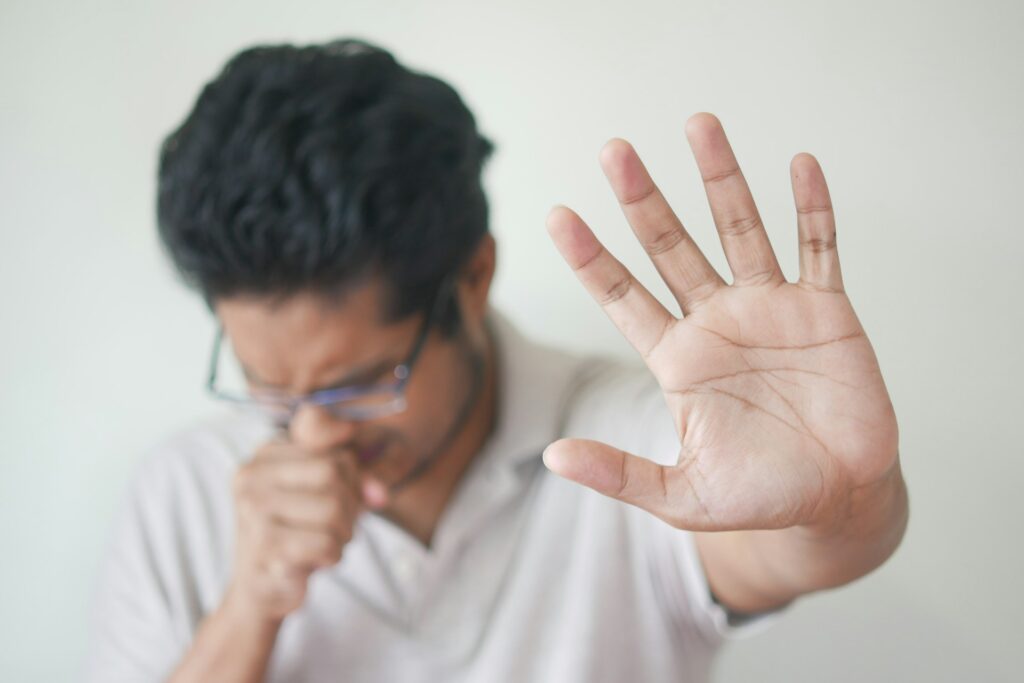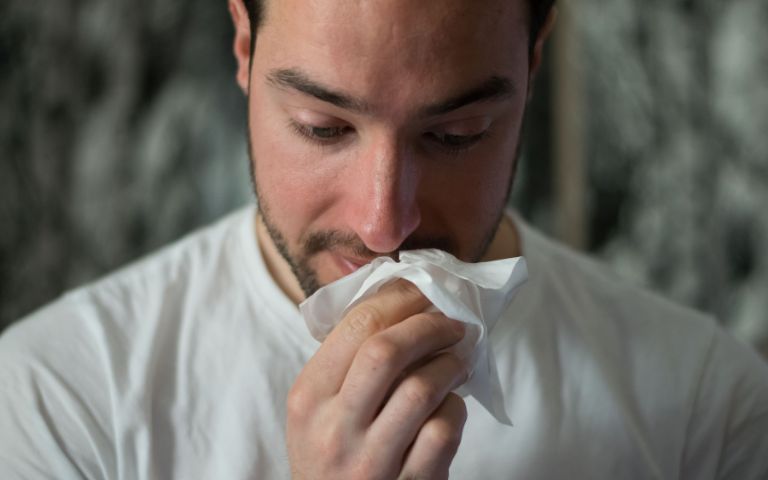Hay fever, medically referred to as allergic rhinitis is a common allergic condition that refers to a group of allergic hypersensitivity reactions in the nasal mucosa and the conjunctiva of the eye. Contrary to what the name “hay fever” suggests, it is not caused by hay, and it seldom results in fever. Allergic rhinitis affects around 18% of children and adults in Australia and New Zealand.
Hay fever (allergic rhinitis) is caused by an allergic response to airborne environmental allergens (indoor or outdoor) such as pollen, dust mites, perfume, pet fur or dander, mould or fungi, and cigarette smoke. In Melbourne, the grass pollen from various types of grass can significantly contribute to hay fever symptoms, especially during the warmer months.
Why is Hay Fever Prevalent in Melbourne?

Satellite images comparing vegetation greenness in Victoria for September 2024 (left) and September 2023 (right), adapted from the Bureau of Meteorology.
The 2024 Victorian grass pollen season looks similar to last year, with around 28 high and extreme pollen days expected between October and December. However, this depends on spring rainfall—if we get above-average rain, grass growth could spike, making hay fever and asthma worse.
Melbourne’s temperate climate is perfect for hay fever, encouraging the growth of allergenic ryegrass, a major trigger for symptoms. Unpredictable weather patterns lead to erratic pollen production year-round, making it difficult for allergy sufferers to manage their symptoms.
Known as the “thunderstorm asthma capital” of the world, Melbourne has experienced four significant asthma epidemics:
- 1987: A thunderstorm on November 8 caused a spike in asthma-related hospital admissions.
- 1989: Similar storm conditions on November 29–30 led to a surge in asthma cases and emergency visits.
- 2010: Another thunderstorm asthma event on November 25 highlighted the city’s vulnerability.
- 2016: The most devastating event on November 21 resulted in ten fatalities and over 3,500 respiratory-related hospital visits.
To manage these risks, Melbourne monitors pollen counts daily from October to January, when pollen levels peak. This helps residents stay informed and take necessary precautions to alleviate hay fever symptoms effectively.
What Causes Hay Fever?

Hay Fever occurs when the immune system mistakenly identifies these airborne environmental allergens as something harmful and launches an “attack” to neutralise the threat. The immune system then triggers the release of an antibody called immunoglobulin E (IgE) to neutralise the threat. A chemical known as histamine released by the immune system is the primary culprit for the common symptoms associated with hay fever.
It is not clear yet what causes the immune system to launch the “attack”, however, there are certain factors that increase your risk of developing allergic rhinitis. Some of the most common triggers that cause allergies in people at different times of the year and in different environmental conditions are:
- Pollens – there are more than 30 different types of pollens that can cause allergies in people and they originate from different sources such as grass, trees, and weeds. It is possible for a person to be allergic to more than one type of pollen.
- House Dust – house dust also contains a number of pollutants (both organic and inorganic) that can trigger allergies. Some of the common allergens found in house dust are dirt, debris, dust mites, fibres, hair, smoke, insects, mammalian dander, saliva and faeces from pets, insects, and mites.
- Fungal Allergens – fungi and mould present in the indoor or outdoor environment also produce large quantities of allergenic spores.
- Pets – household pets such as dogs, cats, birds, chickens, etc are an important source of domestic allergens and can cause severe allergies in people.
- Occupational Irritants – common allergens found in workplaces include different forms of fumes, gases, dust, chemicals, enzymes, powders, asphalt, solvent vapours, diesel exhaust, ammonia, and wood dust.
Melbourne’s Pollen Count

Melbourne’s pollen count is a vital factor for hay fever sufferers in the city. The city’s pollen monitoring system operates from October to January, with the highest levels typically occurring in late November when grass pollen reaches its peak.
Daily pollen counts can fluctuate, and recent reports have indicated moderate weed pollen levels, while tree and grass pollen were not detected.
High-pollen days are defined as having 50 or more pollen grains per square metre, with extreme days exceeding 100 grains. These high counts greatly impact allergy sufferers, making it essential to stay informed about current conditions.
The Melbourne Pollen Count app and VicEmergency app provide real-time updates, allowing individuals to manage their hay fever symptoms effectively.
Awareness of daily pollen forecasts is vital, as symptoms can vary based on individual sensitivity and current atmospheric pollen levels. Residents and visitors with hay fever should monitor these forecasts regularly, especially during peak pollen seasons.
How is hay fever diagnosed?

Diagnosing hay fever involves a thorough approach that includes taking a detailed patient history, performing a physical examination, and conducting allergy tests.
History
Diagnosing hay fever in Melbourne is a detailed process. It starts with reviewing a patient’s medical history and symptoms. Healthcare professionals may conduct allergy tests, like skin prick or blood tests, to identify specific allergens by detecting IgE antibodies.
They may also perform nasal exams to check for inflammation. Melbourne’s hay fever season, which peaks between October and January due to high pollen levels (especially from ryegrass), plays a key role in diagnosis. This thorough approach helps in creating a personalised plan, involving avoidance strategies and proper medications to ease symptoms.
Physical examination
During a physical examination for hay fever in Melbourne, doctors begin by reviewing the patient’s medical history, focusing on allergy symptoms like runny nose, sneezing, and itchy eyes. A nasal exam helps check for inflammation, a common sign of hay fever. To confirm the diagnosis and identify allergens, doctors may perform skin prick or blood tests. The examination also ensures that hay fever is correctly distinguished from similar conditions, such as the common cold.
Allergy testing
Allergy testing is essential for diagnosing hay fever in Melbourne, especially from October to January. Healthcare professionals commonly use skin prick tests, where small amounts of allergens are applied to the skin to check for redness or swelling, indicating sensitivity to local grasses and tree pollens. If skin testing isn’t possible, blood tests can measure the immune response to specific allergens.
Allergists combine these test results with a detailed review of the patient’s history and symptoms to ensure an accurate diagnosis. Once confirmed, they create a tailored management plan to help residents manage pollen exposure and alleviate the effects of allergic rhinitis.
Managing Hay Fever Effectively

Although there is no cure for allergic rhinitis (hay fever), the symptoms associated with this common allergic condition can be relieved or managed by using various treatment modalities.
Preventative Measures
- The best and easiest way to manage the symptoms associated with seasonal or perennial forms of allergic rhinitis is to avoid the allergens that trigger them. The following steps can be taken to avoid indoor or outdoor exposure:
- keep windows, doors, and vents closed to keep the allergens at bay.
- use “mite-proof” covers.
- wash your bed sheets, sofa covers, comforter covers, blinds, and curtains frequently.
- keep the indoor humidity between 30 -50%.
- keep the floors, carpets, and rugs clean at all times.
- avoid going outdoors during the peak allergy season.
- wear sunglasses when outdoors.
- wear a pollen mask when outdoors.
Medication Options
Sometimes it’s hard to avoid the allergens that trigger hay fever with these simple steps. Under such circumstances, your doctor (allergist) may prescribe different medications to relieve different symptoms.
Various medications available to treat different symptoms of hay fever are:
- Intranasal corticosteroids: These are effective for hay fever because they reduce inflammation in the nasal passages, addressing the root cause of symptoms. Regular use is necessary for optimal results.
- Antihistamines: These medications block the action of histamine, a chemical that triggers allergic reactions, thus alleviating symptoms like sneezing, itching, and runny nose.
- Combination medicines: These offer the benefits of both antihistamines and intranasal corticosteroids, providing comprehensive relief by targeting multiple aspects of hay fever symptoms.
- Decongestant sprays: They quickly relieve nasal congestion by constricting blood vessels in the nasal passages, but should be used cautiously to avoid rebound congestion if used for too long.
- Decongestant tablets: These also help relieve nasal congestion but may cause side effects like increased blood pressure or anxiety. They can be useful for short-term symptom relief.
Non-Medical Treatments
Non-medical treatment for hay fever may include the use of natural products and alternative therapies.
- Saltwater/saline nasal sprays: These rinse out allergens and mucus, relieving congestion and irritation while moisturising the nasal lining.
- Herbal medicines: Herbs like chamomile and ginger have natural antihistamine properties that help alleviate symptoms and support the immune system without side effects.
- Acupuncture: This technique may relieve hay fever by balancing the body’s energy flow and reducing inflammation, serving as a complementary treatment for allergies.
Desensitisation Treatments
Desensitisation, also known as allergen immunotherapy, is used to reduce the severity of symptoms and dependency on regular use of medications.
Immunotherapy involves gradually administering small amounts of allergen extracts by means of drops, tablets, sprays, or injections. It is a long-term treatment and may take up to 3-5 years to achieve good results. Two types of immunotherapy are available:
- Allergy shots: These immunotherapy injections expose the body to small amounts of allergens to gradually desensitise the immune system, leading to long-term relief from hay fever symptoms.
- Sublingual tablets: These tablets dissolve under the tongue, providing gradual exposure to allergens. They aim to desensitise the immune system and reduce symptoms, offering a convenient at-home treatment option.
Resources for Hayfever in Melbourne
Melbourne offers a range of resources for those suffering from hayfever, including local health services and community support groups.
Local Health Services
Residents suffering from hay fever in Melbourne have access to an extensive network of local health services and resources. General practitioners (GPs), allergists, and respiratory specialists offer personalised management and treatment options for those affected by seasonal allergies. These medical professionals can provide tailored advice, prescribe medications, and recommend lifestyle adjustments to minimise symptoms.
The Victorian Department of Health serves as a valuable resource, offering guidelines on hay fever management, including information on recommended medications and environmental modifications.
Local pharmacies stock a wide range of over-the-counter remedies, such as antihistamines, nasal sprays, and eye drops, specifically formulated to alleviate hay fever symptoms.
Community health centres play an essential role in educating the public about allergy management. These centres frequently organise workshops and seminars, providing information on pollen forecasts and effective coping strategies.
Community Support Groups
Support networks play an essential role in helping Melbourne residents manage hay fever and its associated challenges. Here are some examples of community support groups and resources for hay fever in Melbourne:
- Asthma Australia (Facebook): Provides resources and guidance for managing asthma and hay fever, helping prevent asthma flare-ups caused by allergies.
- Melbourne Pollen Count and Forecast (Facebook): Offers real-time pollen updates, allowing residents to plan outdoor activities and minimise exposure during high pollen days.
Pollen Count Monitoring Tools
For individuals grappling with hay fever in Melbourne, access to accurate and timely pollen count information is vital. The city offers several reliable tools to monitor pollen levels and manage allergy symptoms effectively.
- Melbourne Pollen Count App: This app provides real-time pollen forecasts based on data collected from a statewide network of monitoring sites. It alerts users to high pollen levels, helping them manage their hay fever symptoms effectively.
- VicEmergency App: This app offers pollen forecasts alongside air quality updates, enabling users to make informed decisions about their daily routines.
Educational Resources on Allergies
To empower Melbourne residents in their battle against hay fever, a wealth of educational resources is available.
- Better Health Victoria: Offers detailed information on hay fever management, focusing on allergen identification and exposure reduction strategies.
- Allergy Aware: Provides guidelines for anaphylaxis prevention and management, particularly in educational settings, to help educators and caregivers support children with allergies.
- National Asthma Council Australia: Supplies educational packages for asthma care providers, including allergy management guidelines for schools and sports clubs.
- Australasian Society of Clinical Immunology and Allergy (ASCIA): Delivers extensive resources on allergy testing, treatment options, and management plans, including action plans for individuals with allergies.
When to Visit Your GP?
Hay fever can significantly affect your daily life, so it’s important to know when to see your doctor for evaluation and treatment. Here are some signs to help you decide when to make an appointment:
- Persistent Symptoms: If your symptoms last more than a week or don’t get better with over-the-counter medications, it’s time to reach out for help.
- Severe Reactions: If you’re having trouble breathing or notice any swelling, don’t wait to get checked out.
- Worsening Asthma: If your asthma symptoms are flaring up more than usual during hay fever season, it’s a good idea to consult your doctor.
- Signs of Infection: If you develop a fever, facial pain, or unusual nasal discharge, these could be signs of an infection that needs attention.
- Mental Health Concerns: If your hay fever is affecting your mental well-being, talk to your GP about it.
- Considering Alternatives: If you’re thinking about trying alternative treatments, your GP can help you navigate the options safely.
- Regular Check-ups: If it’s been a while since your last visit, especially during the hay fever season, it’s worth scheduling an appointment.
Don’t hesitate to seek help—getting the right support can make a world of difference in managing your symptoms effectively!
Frequently Asked Questions
Hay fever season in Melbourne typically occurs from October to January, with peak pollen levels in late November. The season aligns with grass pollen production, particularly ryegrass, which is most prevalent during summer months, especially December.
Yes, hay fever is prevalent in Australia. It affects many Australians, particularly in urban and rural areas. Pollen from various plants, including grasses and trees, can trigger symptoms such as sneezing, itchy eyes, and nasal congestion.
Hay fever is typically worst in Australia during spring and early summer, peaking from October to January. This period coincides with high pollen levels from trees and grasses, particularly in late November when temperatures rise and plant activity increases.
Yes, there is a dedicated hay fever app for Melbourne called the Melbourne Pollen Count app. It provides real-time pollen forecasts, alerts, and historical data, helping users manage their allergies and plan outdoor activities more effectively.

